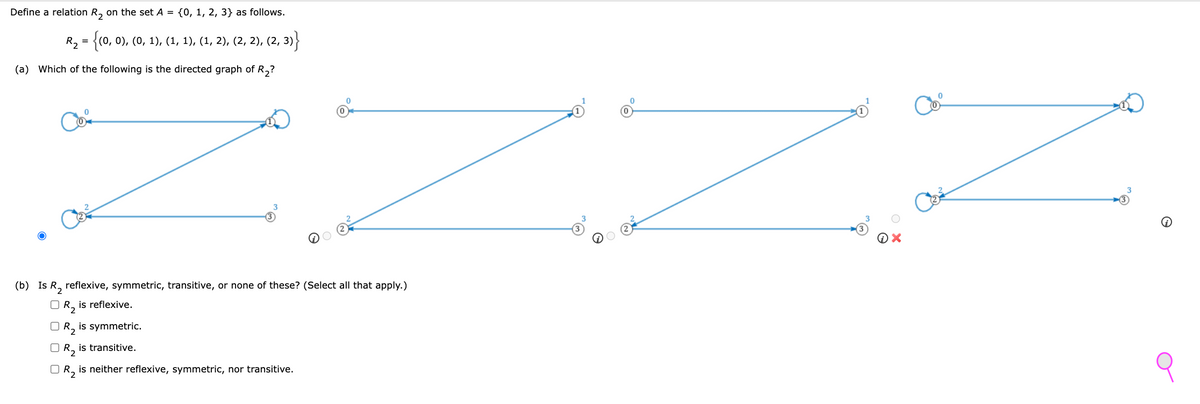Define a relation R, on the set A = (0, 1, 2, 3) as follows. R, = {(0, 0), (0, 1), (1, 1), (1, 2), (2, 2), (2, 3) (a) Which of the following is the directed graph of R,? (b) Is R, reflexive, symmetric, transitive, or none of these? (Select all that apply.) OR, is reflexive. OR, is symmetric. OR, is transitive. OR, is neither reflexive, symmetric, nor transitive.
Define a relation R, on the set A = (0, 1, 2, 3) as follows. R, = {(0, 0), (0, 1), (1, 1), (1, 2), (2, 2), (2, 3) (a) Which of the following is the directed graph of R,? (b) Is R, reflexive, symmetric, transitive, or none of these? (Select all that apply.) OR, is reflexive. OR, is symmetric. OR, is transitive. OR, is neither reflexive, symmetric, nor transitive.
Elements Of Modern Algebra
8th Edition
ISBN:9781285463230
Author:Gilbert, Linda, Jimmie
Publisher:Gilbert, Linda, Jimmie
Chapter1: Fundamentals
Section1.7: Relations
Problem 14E: In each of the following parts, a relation is defined on the set of all human beings. Determine...
Related questions
Question

Transcribed Image Text:Define a relation R, on the set A = {0, 1, 2, 3} as follows.
R, = {(0, 0), (0, 1), (1, 1), (1, 2), (2, 2), (2, 3)
(a) Which of the following is the directed graph of R,?
(b) Is R, reflexive, symmetric, transitive, or none of these? (Select all that apply.)
O R, is reflexive.
O R, is symmetric.
O R, is transitive.
O R, is neither reflexive, symmetric, nor transitive.
Expert Solution
This question has been solved!
Explore an expertly crafted, step-by-step solution for a thorough understanding of key concepts.
This is a popular solution!
Trending now
This is a popular solution!
Step by step
Solved in 3 steps with 4 images

Recommended textbooks for you

Elements Of Modern Algebra
Algebra
ISBN:
9781285463230
Author:
Gilbert, Linda, Jimmie
Publisher:
Cengage Learning,

Elements Of Modern Algebra
Algebra
ISBN:
9781285463230
Author:
Gilbert, Linda, Jimmie
Publisher:
Cengage Learning,